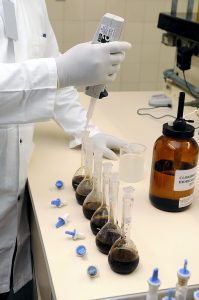What makes a wine sweet and what makes a wine taste sweet? As you might expect in the convoluted world of wine, the two are not the same. In the wine world, things are not always what they seem.
Wine sweetness is determined by “residual sugar” or RS. There are other mechanisms both artificial and natural that give you the sensation of sweetness, but wine’s definition of sweetness focuses on RS.
When yeast eats the sugar in grape juice it turns natural sugars into alcohol and carbon dioxide (CO2). If the winemaker allows the yeast to eat all the sugar, the alcohol level increases and the RS goes down, in many cases to zero or close to zero. Such wine clearly qualifies as “dry wine.”
If the winemaker at some point stops the conversion of sugar into alcohol and CO2, then the wine will have measurable amounts of RS. At higher levels of RS, such wine clearly qualifies as “sweet wine.”
The devil, of course, is in the details and the shades of difference between no RS and a lot of RS.
Sweet wines are officially classified as having 45 grams or more per liter (g/L) of RS. Basic sweet wines have 45-120 g/L. Dessert wines 75-200+ g/L. Extremely sweet wines such as some pedro ximénez sherries or Tokajis contain 400+ g/L.
Most dry wines have 0-4 g/L, but if the wine has high acidity it can have up to 9 g/L—that will get us into the weeds of how we perceive sweetness later in this piece. Some supermarket reds labeled “dry” will have 10 g/L—mass market wineries do not go broke selling sweetened wines.
There is a middle ground of “off-dry” and “semi-sweet” wines. Off dry, also known as “medium-dry,” have 4-12 g/L. Medium-sweet has 12-45 g/L. As mentioned, 45 g/L is generally held as the dividing line between sweet and dry.
But measures of RS obtained from white-coated wine wonks in test-tube infested laboratories is not how you experience wine sweetness. Oh, no. Mother Nature and physiology have a magician’s hat of tricks to amuse and confuse you. Here are major ones:
• Acidity. Acidity is measured two ways: pH (potential Hydrogen) and TA (Titratable Acidity). They are two different measurements. Wine pH is the concentration of free hydrogen ions and indicates the strength of acidity. The pH scale is logarithmic and runs from 0 to 14, with water in the middle at 7. A pH score of less than 7 is acidic, more than 7 is alkaline. Most wines score between 2.8 and 4.2. Takeaway: the lower the pH number, the more the acidic strength.
TA measures the quantity of acids. Wines can have identical TA scores but different pH scores depending on buffering compounds, mineral content, and the type of acid (there are six different types in wine, with tartaric, malic, and citric the most noticeable). TA is the key indicator as to how tart or sour a wine will taste. Red wine TA generally ranges from 5.5 to 7 g/L, while white wines range from 6.0 to 8.5 g/L. Takeaway: the higher the TA number, the more tart the wine.
When it comes to sweetness, pH and TA influence your perception. Acidity counteracts sweetness. Very sweet wines like port and sherry usually have high acidity which prevents them from tasting cloying or syrupy. On the other hand, lower acidity allows the natural sweetness of wine to come through, resulting in a rounder, softer mouthfeel often described as silky and smooth. Too little acidity creates wines that are “flabby”—dull, heavy, flat—and also emphasizes the perception of alcohol, making the wines taste “hot.”
Okay, we mowed our way through the wine acidity weeds, but our trek into the jungle of wine sweetness perception is far from over.
• Fruit ripeness. Ripe fruit contains more sugar, which yeast will convert into alcohol and CO2, which makes the wine dry. Yes, dry when RS is measured, but the human body is not a laboratory instrument. Fruit ripening transforms grape flavor from green and herbaceous to citrus and orchard fruits in white wines and red and black fruits in red wines. When grapes reach full phenolic ripeness—which includes tannins, flavonols, and other phenolic compounds—your sense of smell (which very heavily influences your sense of taste) and mouthfeel tell your brain this is sweet even when RS is low. Juicy, ripe fruit wines taste sweet even though they are not sweet, measured by sugar content.
• Alcohol. You perceive ethanol—the alcohol in wine—as sweet even though it has no sugar content. High alcohol wines usually mean ripe fruit wines, so the perceptions support each other. High alcohol, ripe fruit wines taste sweet even if there is little or no RS.
• Oak. Aging wine in oak can significantly enhance sweetness perception. Oak extracts vanilla, caramel, chocolate, butterscotch, coconut, and other aromatics and flavors strongly associated with sweetness.
• Glycerol. A natural byproduct of fermentation, glycerol contributes to wine texture, viscosity, and mouthfeel. Again, signals to your brain that mimic sweetness signals regardless of sugar content.
So, truly sweet wine—measured by sugar content—can be perceived as not so sweet when there is high acidity. Truly dry wine—measured by absence of sugar—can be perceived as having sweetness because our sensory perceptions of wine sweetness are influenced by many factors beyond actual sugar content.
Human beings are complicated and our perceptions of the world and wine are influenced by a motley mob of influencers. If it were simple, wine would not be so wonderful.
Tasting notes:
• Dr. Konstantin Frank Célèbre Riesling Cremant, Finger Lakes NV: Sparkling riesling is not common wine. Excellent, a great bargain, demonstrates how well the Finger Lakes region is doing with riesling. Fruity, inviting, easy drinking, vivid acidity (2.86 pH). $25 Link to my review
• Bodegas Barbadillo La Cilla Pedro Ximenez Jerez-Xérès-Sherry: Unctuous, delicious exaltation of dark, jammy fruits embraced by good, balancing acidity. Sweet, rich, complex, decadent. Made using pedro ximénez grape, known for its rich sweetness, as this effort emphatically demonstrates and celebrates. $30 Link to my review
• Concannon Vineyard Mother Vine Reserve Cabernet Sauvignon, Livermore Valley 2020: Made using foundational California cabernet sauvignon clones from the mother vines. Features elegance over power. Excellent fruit and balance, smooth and easy in the mouth (3.70 pH; 6.7 g/L TA). $55 Link to my review
Last round: If a child refuses to sleep at nap time, are they guilty of resisting a rest?
Wine time.


